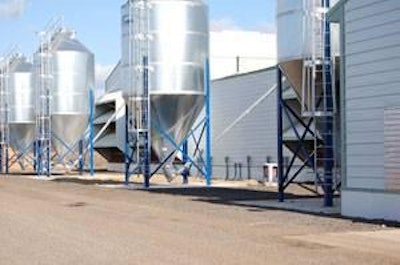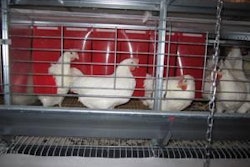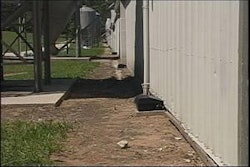
The Chinese philosopher, Lao Tzu, said, “A journey of a thousand miles begins with a single step.” The thousand-mile journey for the U.S. egg industry may be the conversion from traditional cage systems to enriched colony housing. The first step was taken by JS West with the placement of a flock in the company’s enriched colony barn in July 2010. Konos Inc. took the second step in fall 2011 by placing a flock of 120,000 hens in an enriched colony house, which was built as part of a 720,000-bird, four-house expansion.
Preparing for change
Rob Knecht, operations vice president, for Konos Inc., is a grandson of the company founder, Howard Vande Bunte, and nephew of the company president, Tim Vande Bunte, and the COO, Paul Vande Bunte. Because of changing attitudes in the country regarding bird welfare, research results, and the political activities of animal rights groups, Knecht said that it was apparent that big changes were coming for the U.S. egg industry. Knecht stated, “Tim and Paul really thought that there was going to be a big shift in hen housing. Enriched housing is the most logical alternative. It is better for the bird. Hens are calmer, healthier and have less mortality. It is a great way to house the hens.”
The Vande Buntes decided to build enrichable houses well before Michigan’s law addressing laying hen housing was signed into law by the governor in the fall of 2009.
The new Michigan law set standards for housing veal calves, sows and laying hens. Under the Michigan statute, a hen must be able to “fully extend its limbs, which means fully spreading both wings without touching the side of an enclosure or other egg-laying hens and have access to at least 1.0 square foot (144 square inches) of usable floor space per bird.”
Commenting on Konos’ decision to expand the farm by building four new layer houses, Knecht said, “Tim and Paul decided to expand because they thought the volume required to be a relevant national player or producer was to produce around 1.5 million eggs per day.” With the additional hens in the three new enrichable and one enriched colony barns, the farm can now house around 2 million layers and produce 1.5-1.6 million eggs per day.
Enriched and enrichable houses
Enriched colony housing systems are designed to allow birds to more fully express natural behaviors such as wing flapping, nesting, foraging, perching and dust bathing. To accommodate the cage enrichments and allow expression of these behaviors, more floor space is provided per hen. Besides the extra floor space per bird, enriched enclosures tend to be around 4 inches taller to accommodate perches and allow for wing flapping. The combined impact of the increased floor space provided per hen and the increased cage height means that an enriched colony housing system providing between 116-124 square inches per hen requires roughly twice as much cubic footage as does a conventional belt cage system with birds housed at 67 square inches per bird.
The four new houses at Konos are each 62 feet wide, 454 feet long and 24 feet high. A two foot high concrete curb is topped with wood-framed insulated walls with painted metal siding. The housing enclosures are Big Dutchman Avech systems stacked eight high with a catwalk installed four rows up. Each of the three enrichable barns house around 200,000 hens at 67 square inches per bird. Hens in the enriched colony house are placed at 116 square inches per bird, which is the standard density in the EU. An individual colony enclosure is 12 feet long, 50.4 inches wide, and the total height including the manure belt is 26.77 inches, a full four inches taller than a conventional belt battery cage. Each colony has two scratch areas, two nests and five perch rods that allow six inches of perch space per bird. At 116 square inches per hen, the colonies house 61 hens each at Konos.
The central perch is the pipe for the feed auger that delivers feed to the scratch areas. Each time the chain feeder runs, the feed auger used to distribute feed to the scratch area will run for 15 seconds. The feed drops out of the pipe onto the top of the ventilation tube, and as it spreads out onto the scratch pad attracts the birds and gets them to peck and move around in the scratch area.
Improved pest control
The new barns can operate in tunnel mode in the summer time with inlets at one end, and a bank of fans at the other end. The rest of the year, sidewall fans are used to create negative pressure in the house and draw air in through attic inlets.
Attic and house air is drawn into a system, which is used to distribute air into the individual enclosures, and blow it across the manure belts. Drying the manure prevents ammonia production, and keeps fly larvae from developing.
Knecht said that the two-foot concrete footer, solid house construction and the manure belt system create an environment for the birds where rodents and flies are not problems. He said that the new houses represent a significant improvement over the farm’s high-rise houses where a large amount of time and money must be expended to control these pests.
LED lighting
The enriched colony house has AgriShift LED lights from Once Innovations Inc., which are full-spectrum lights with enhanced luminous power in the red wavelengths. The bulbs can be dimmed from 100% to 2% and mimic sunset and sunrise by shifting to all red when dimmed to very low levels. At a price of $60 a piece, Paul Vande Bunte said that the bulbs will likely not pay for themselves based on energy savings alone. The manufacturer claims improved bird performance as a response to the differences in the wavelengths of light emitted from these lights as compared to fluorescent and incandescent lighting alternatives.
The lights are placed at the scratch area end of the colony enclosures so that it is darker at the opposite end where the nests are located. Higher light levels in the scratch areas are expected to draw birds away from the nests after they have laid an egg.
Processing plant improvements
Knecht said that when Konos added the new houses, the company also needed to increase the rate at which they processed the eggs to keep up with the increased output. Konos replaced its old egg inspection, washing, and packing equipment with systems from Moba that handle 500 cases per hour. The transition to this new equipment and packing rate has been extremely successful, according to Knecht. Even though Konos now packs 50% more eggs, the number of checked eggs produced per week has been cut in half.
Konos operates one egg packing shift and a sanitation shift each day. The plant operates seven days per week, and the entire complex has just under 100 employees.
The other houses
In addition to the four new houses, Konos has 12 other layer houses and four pullet houses. Ten of the older houses are high-rise houses, and two are belt battery houses.
White egg layers in the old barns are housed at 67 square inches per bird, and the brown egg layers in two barns are housed at 76 square inches per bird.
Feed for the birds is produced at an onsite feed mill. Vande Bunte said that Konos can procure all of its corn needs from farms within around 30 miles of Konos. DDGS are not used in their rations.
Industry future
The transition to enriched colony housing has the opportunity to be as big a seismic shift for the egg industry as the move into cages was two generations ago. Because of the large capital investment required to convert old houses, and to build new houses to make up for reduced housing densities, the move to enriched colony housing could force some producers out of production, or it could trigger a round of consolidation in the industry.
When asked where Konos stood on the UEP-HSUS agreement and the lobbying effort calling for national legislation, Vande Bunte said, “We are a UEP certified farm, and we fully support the UEP-HSUS agreement and what Gene Gregory of the UEP and Wayne Pacelle of the HSUS have worked towards. We have shown that sentiment not only in words, but through our actions and investments in the HSUS approved, colony enriched systems.” He also said that Michigan Allied Poultry Industries Inc. is lobbying to get the UEP-HSUS agreement language adopted as legislation by Congress.
Knecht stated, “If there is not an agreement, there will still be a decades long transition to enriched colony housing, unless it is customer driven and they demand eggs from enriched colony housing, then it will happen faster.”
Some farms have added enrichable housing over the past year without reducing the number of layers in existing houses. Egg Industry asked Knecht if these housing expansions might negatively impact egg prices in the short term. He replied, “Eventually, as the egg industry retools it will force producers to try and maintain layer numbers and not decrease or increase them.”
Konos is working now to develop a market for the eggs produced in the enriched colony house. As of mid-November 2011, hens had been in the enriched house for six weeks, and their eggs were being mixed with the other eggs.


















